Paleolithic Hands
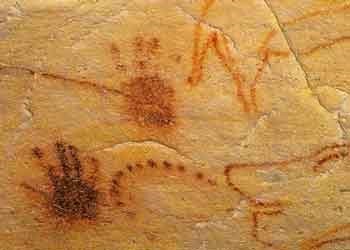
More moving almost than even the artistic representations, the imprints left by human hands on the walls of prehistoric caves create an authentic link between Paleolithic man and us. These oh, so real! and concrete traces bring us back to our own childhood memories, when we used to print our hands on a white page, or simply into the wet sand…
The pictures of hands found on the walls of caves were applied according the several techniques. The great majority of them are negative hands, which appear in the middle of a halo of color. One finds also positive hands, distinctly fewer in numbers, reminding one of the colored imprints everybody has done in his childhood. The rarest technique consists in engraving the hand into the rock. One may also cite imprints dug into a support such as wet clay or woolmich – but then, it becomes difficult to make out whether this would have been a voluntary act, or merely a trace left by someone trying to take a hold…
If we decide a priori to include representations of hands as part of the art of cave painting, we must conclude that hands are among the most used representations. And, among these, the negative hand is over-represented.
A more detailed study reveals that hands are in most cases isolated from other representations, even in those cases where the cave is rich in other themes. However at Gargas or Del Castillo the hands are largely in the majority, and sometimes they form gigantic panels displaying a great variety of authors. At Tibiran, one single panel shows 9 isolated negative hands.
Sometimes, the hands come in pairs and, quite often, one can find two isolated hands distinctly separated from the other images, such as in the cave of Bernifal.
Frequently too, one can find single, isolated imprints, as in the sites of Cosquer, les Combarelles, the abri du Poisson, and even sometimes they appear « framed in, » such as at Gargas.
Extremely rarely, hands are associated with other representations, the example of Pech Merle immediately coming to mind, with its magnificent horses punctuated with 11 negative hands… (Picture)
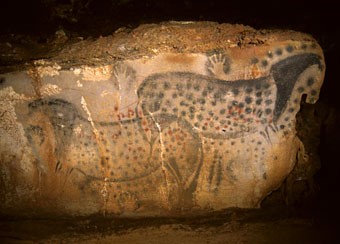
Left or right?
Without it being of primordial importance, one may ask the question: which one of his hands did prehistoric man preferably represent on his walls? According to a study carried out by prehistorian Marc Groenen, out of 378 negative hands, it was possible to identify 285 left hands and 95 right hands. 75,4 % of the imprints are therefore of left hands, and 24,60 % of right hands.
While doing some experiments themselves, prehistorians came to realize that, quite naturally, a right-handed person puts his or her left hand on the wall in order to keep its right hand active. If we apply this habit to our ancestors, we can deduce that 75% of paleolithic men were right handed. This is a smaller proportion than is the case today, where it is estimated that the modern population is 90% right-handed.
A hand the thumb of which is to the right corresponds to a left hand if it has been applied to the wall in pronation (with the palm against the wall) but it signals a right hand if it has been applied in supination (with the back of the hand against the wall). We were able to show that the hands were applied in pronation, and it is therefore possible to determine the laterality of the hand taking into account the position of the thumb. Marc Groenen.
A gauche : Mains peintes dans la grotte de Bernifal
Negative, positive and incomplete hands
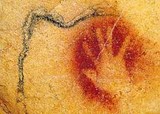
Negative hands
Several prehistorians have been interested in the way in which the humans of the Paleolithic realized negative hands. One may cite André Leroy-Gourhan, Michel Lorblanchet and Marc Groenen (1988). In various publications, two methods are most often discussed: either the color is laid down around the hand, or it is projected by means of a tube and « spit » out. If Michel Lorblanchet carried out experiments projecting the coloring matter by way of the mouth, according to Marc Groenen, it took some sort of vaporisation of the paint, realized by means of a small bent tube. In all cases, the hand is held against the wall with fingers splayed, and when it is removed, its shape appears on the wall in negative form. In most cases, the shape is neat and sharp, and often it includes the wrist, and even, rarely, the lower part of the arm. (Picture: Chauvet Cave, France)
Positive hands
In the case of positive hands, the method is more simple and straightforward. Paleolithic man dipped his hand into a coloring mixture, smearing some of it on his hand. He then applied his hand to the wall for a few moments, in order for the paint to get transfered onto the base. (Picture: Chauvet Cave, France)
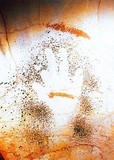
Incomplete hands
Many of the hands represented on the cave walls are incomplete : the middle finger, or another finger, or several fingers do not appear whole. Much ink has flowed over these intriguing, even disturbing, visual mutilations. (Picture: Cosquer Cave, France)
Voluntary mutilation
It is imaginable that in Paleolithic human societies some individuals might have voluntarily severed one or more of their fingers in order to satisfy a rite. This could be some sort of a « passage obligé, » showing one’s belonging to a group. This theory has been gradually abandoned, as it is not easy to grasp why the members of hunter-gatherer tribes would voluntarily mutilate themselves, thus diminishing their hability and their capacities in gathering food. Moreover, such mutilations would also have been a source of dangerous infections.
Involuntary mutilations
Another theory could explain these mutilated hands: illness, accidents or frost. Which goes to say that the hands are incomplete because paleolithic artists would have often been extraordinarily clumsy or unlucky!
Besides the anecdotal aspect of a prehistoric klutz chopping off his fingers by mistake, it seems statistically improbable that the humans of the period would have caught several illnesses, or have had their fingers frozen off. Moreover, some fingers like the middle-finger are often incomplete, whereas the thumb is almost always intact. Such a selectiveness does not correspond to any particular pathology known.
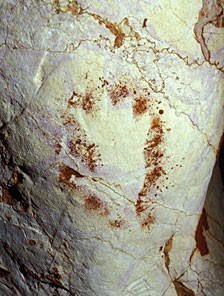
Bent fingers
The explanation that is most often accepted is also the simplest: that the fingers were bent. It suffices for our artist to bend one of the other of his fingers when he applies the paint to produce the imprint of an incomplete hand. Prehistorians such as Lorblanchet, Groenen have demonstrated through experimentation that it was quite possible to produce « mutilated » hands by positioning some of the fingers under the others. There is no absolute proof to bolster this hypothesis, but it has the merit of being simple and easy to carry out. (Picture: Cosquer Cave, France)
Dating
Direct dating of the painted or engraved hands is very difficult. For paints using a coloring agent, the latter must be organic (such as charcoal) for Carbon 14 dating to become possible…
In the case of engravings, dating is impossible except if a connected external element present close-by is datable, such as, for instance, in the case of a cave the entrance of which has collapsed. For the sites where dating is possible, the majority of the prehistoric hands date back to the Gravettian and are estimated at – 27 000 to – 22 000 years.
Why these traces of hands on cave walls ?
As is the case for prehistoric art in general, the question of "why" also applies to prehistoric hands... We are seeking the intellectual reasons which could have prompted humans, over 20,000 years ago, to print their hands on walls. It is quite a challenge to try to put oneself in their place. In our present day societies, the hand symbolises strong ideas of communication, of welcoming, of signature… When we are looking at the hands represented on cave walls, we can hardly extract ourselves from our own context and project ourselves in paleolithic times…
Hands of men or of women?
Granted that we cannot know the "why" of these imprints, it has become possible at present to determine whether a hand represented on a cave wall belonged to a man or a woman.
Jean-Michel Chazine (CNRS) and Arnaud Noury (a computer scientist and a prehistorian) have created a software, Kalimain, allowing one to determine the gender of the artist, making use of the studies of John T. Manning (University of Liverpool, U.K) which show that the ratio in length between the index-finger and the ring-finger is fixed, and different among men and women. Both of these fingers are of the same length in women, whereas there is a measurable gap in the case of men: this is the "index of Manning."
It all begins in December 2004, when researchers Kevin Sharpe and Leslie Van Gelder (3), specialists in finger traces, state the possibility of determining the gender of certain negative hands by means of the Manning index. Indeed, during the first months of life, different hormones directly influence the development of these two digits. Oestrogens accounts for the growth of the index, and testosterone for the growth of the ring finger! A European male has an average rate close to 0.96 and a European female has one close to 1. This gap between men and women is presumably always present.
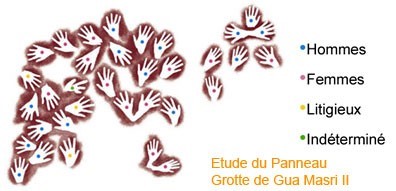
SeeThis then gives Jean-Michel Chazine the idea of using the "Manning-index" in order to decrypt the gender of the prehistoric hands of the Gua Masri II cave which he is studying in East Borneo. He takes up contact with Arnaud Noury, an archaeologist and computer expert. Ten days later, the first results land on his desk: it's a deeply moving result. Chazine sees on his computer screen the panel of hands which he has been studying for years, but this time, they carry blue marks for the men and red marks for the women… Suddenly, the panel starts speaking to him: there is a deliberate organization at work. Moreover, it appears clearly on the screen that the distribution of hands between men and women are not the same from one spot to the other. What then do these hands signify? The mystery still hovers. Only one thing is certain… « The imprints respond to a specific need, explains Chazine. Let’s take the cave of Masri. There are only negative imprints there. It was never inhabited…. Meaning that, at a certain moment, men and women came there especially with the purpose to put their hands on the walls, it was certainly with a very precise goal, and it followed certain rules. Men and women did not mix up their hands.» The researcher has come up with a few hypotheses: maybe that these hands were symbolic representations and might correspond to therapeutic, magical, religious, or divinatory rituals, or they were the signs of initiation rites. The researcher and the computer scientist can still refine their software, with the goal of correlating chronologies and localisations with the number of hands, their resemblances and their differences, the links between motives and colors. And make out, maybe thanks to sexual differentiation, some new cultural eras of prehistory… »
See: Kevin Sharpe et Leslie Van Gelder, « A Method for Studying Finger Flutings », à consulter sur www.ksharpe.com/word/AR47.htm et à paraître in Exploring the Mind of Ancient Man : Festschrift to Robert G. Bednarik.
See also: J. T. Manning, Digit Ratio, a Pointer to Fertility, Behaviour and Health, Rutgers University Press, 2002.
The Cosquer Cave
The software has also been used to study other caves, such as Cosquer. The hands at Cosquer have the pecularity of being incomplete : most of the imprints show only 2 or 3 fingers. The Manning index can therefore not be used. But when applied to the complete hands, the software made it possible to determine that female hands were more numerous at Cosquer than male hands.
The Cosquer Cave (near Marseille, France) was discovered in 1985 by a diver (the original entrance was placed 37 meters below the present level of the sea), but its paintings were only mentioned in 1991, after three divers found their death in the cave, where they had gotten lost. The gallery goes back up some 120 meters, all the way to a large hall which has remained in part above water. A great number of cave paintings are there, as well as remains on the floor (charcoals from fires, torches, cut silex). It is the only painted cave known in the world with a sub-marine entrance and the cave art of which has been preserved from the general rise of the waters at the end of the last ice age.
It was evident from the beginning that the Cosquer Cave would both important and original. It was situated in Provence, near Marseille, in an area where never up to that point any paleolithic art had been discovered. It brought to light a problem well known in principle, but not often addressed, of the disappearance below the sea, since the ice ages, of a large number of caves around the Mediterranean and on other coastlines. Several other large caves exist around Cosquer. Some may have been – and probably were – ornated and inhabited.
Despite destructions due to the sea, Cosquer belongs among the rare caves where more than 150 animal figures have been recorded. The negative hands amount at present to 65, which places Cosquer, as far as Europe is concerned, right after Gargas (Upper Pyrénées, France) and maybe before El Castillo, in Spain. All the hands are localized on the eastern side of the cave. There are none on the western side. Some, which are are right at the edge of a 19 meter deep well – a place which must have had significance in itself - are all black. On other panels, the hands come in black or in red. Some have been scraped and painted over with dots and bars. Many have incomplete fingers: they were made with some fingers folded. Negative hands with incomplete fingers had only been found up to then in some rare caves, especially in the Pyrenées (Gargas, Tibiran, Fuente del Trucho). We know now that this phenomenon was more common than has been thought. The established fact that around the same time negative hands could be found hundreds of kilometers apart should deal the death blow to any theory of pathological mutations : is it believable that human groups so far apart from each other would have been afflicted by the same mutilating illnesses? And have responded in the same way, by immortalizing them on the walls of caves, using the same techniques ?

Imprints of childrens’ hands have been observed on the mondmilch (a soft and altered limestone surface) high up on some walls, ca 2.20 meters from the floor. This means that the children had access to the depths of the cave and that they have been help up in arms, or put on the shoulders of adult, in order to be able to imprint their hands high up on the surface of the rock. This is not a fortuitous movement, but a deliberate action.
As for the adults themselves, some of them had had to be over 1.85 meter tall (6ft 1"!), judging by the height of some of the engravings and the impossibility to place ladders in the particular places where they are found.
Translated from the French and adapted by Anne-Marie de Grazia
from several articles published on the site Hominidés and authored by Camille LAMOTTE, Jean CLOTTES, Jean COURTIN, Luc VANRELL
http://www.hominides.com/html/art/main-prehistoire.php
http://www.hominides.com/html/actualites/main-kalimain-logiciel-cnrs-sexe-manning.php

